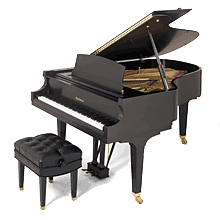
| The Effects of Moving and Storage |
Tuning
A piano is hoisted out of a third-story window, trucked across the province, and later that day hoisted into a
fifth-floor apartment. After the movers leave, the pianist sits down to play and is surprised to find the piano in
very good tune. Two weeks later, the piano sounds terrible.
This common scenario is due to the fact that it is not generally the physical moving of the piano that puts it
out of tune- it is the change in humidity from one location to another, and this change takes anywhere from a
few days to a few weeks to show its effect.
For this reason, you should wait at least 2 weeks after moving before having the piano tuned. Only with
some of the cheaper and smaller apartment size pianos will the actual physical moving affect the tuning
directly.
Pedals
Grand piano pedals are frequently out of kilter after a move. Shims of leather or cardboard used to take up
slack in the trapwork often fall out when the lyre is removed. Also, less careful movers sometimes mix up
the order of the pedal rods that rise from the back of the pedals. These rods are not always equal in length
and so may not be interchangeable. Pedal dowels in verticals also sometimes fall out of place. It is a fairly
simple matter for your piano technician to correct.
Special note: If your grand piano has lyre braces (which it should), be sure the movers remember to put
them back on. Movers often forget and leave them in the truck, never to be seen again.
Other Effects
The effects of moving, except those mentioned above, are very unpredictable, especially if there is a large
difference in humidity between the old and new locations.
Warning: A piano that has been in a damp or unheated place for many years should never be moved to a
dry or well-heated location. Such pianos are known to self-destruct in a short time.
One additional item to check on a grand piano before moving:
Because a grand is placed on its side to be moved, a narrow wooden rail called a key stop rail is mounted
on top of the keys, behind the fallboard, to prevent the keys from falling off the key frame during moving. If the
key stop rail is missing or not securely installed, as sometimes happens, the keys will be in terrible
disarray and completely unplayable after moving. A technician can fix this, but it may take awhile to remove
the action from the piano. If you know you're going to be moving, have your technician check the key stop rail
before you move.
A piano is hoisted out of a third-story window, trucked across the province, and later that day hoisted into a
fifth-floor apartment. After the movers leave, the pianist sits down to play and is surprised to find the piano in
very good tune. Two weeks later, the piano sounds terrible.
This common scenario is due to the fact that it is not generally the physical moving of the piano that puts it
out of tune- it is the change in humidity from one location to another, and this change takes anywhere from a
few days to a few weeks to show its effect.
For this reason, you should wait at least 2 weeks after moving before having the piano tuned. Only with
some of the cheaper and smaller apartment size pianos will the actual physical moving affect the tuning
directly.
Pedals
Grand piano pedals are frequently out of kilter after a move. Shims of leather or cardboard used to take up
slack in the trapwork often fall out when the lyre is removed. Also, less careful movers sometimes mix up
the order of the pedal rods that rise from the back of the pedals. These rods are not always equal in length
and so may not be interchangeable. Pedal dowels in verticals also sometimes fall out of place. It is a fairly
simple matter for your piano technician to correct.
Special note: If your grand piano has lyre braces (which it should), be sure the movers remember to put
them back on. Movers often forget and leave them in the truck, never to be seen again.
Other Effects
The effects of moving, except those mentioned above, are very unpredictable, especially if there is a large
difference in humidity between the old and new locations.
Warning: A piano that has been in a damp or unheated place for many years should never be moved to a
dry or well-heated location. Such pianos are known to self-destruct in a short time.
One additional item to check on a grand piano before moving:
Because a grand is placed on its side to be moved, a narrow wooden rail called a key stop rail is mounted
on top of the keys, behind the fallboard, to prevent the keys from falling off the key frame during moving. If the
key stop rail is missing or not securely installed, as sometimes happens, the keys will be in terrible
disarray and completely unplayable after moving. A technician can fix this, but it may take awhile to remove
the action from the piano. If you know you're going to be moving, have your technician check the key stop rail
before you move.
| © 2000-2021 Concert Pitch Piano Services. All rights reserved. |
| . |
| . |
| . |
| CONCERT PITCH PIANO SERVICES |

| For safe and inexpensive piano storage in Greater Toronto including climate controlled facilities, we recommend Braymore Delivery Co. |
| | EXPERIENCED |
| CERTIFIED |

